Eicosa pentaenoic acid ( EPA or also icosapentaenoic acid ) is an omega-3 fatty acid. In physiological literature, it is given the name 20:5(n-3). It also has the trivial name timnodonic acid. In chemical structure, EPA is a carboxylic acid with a 20-carbon chain and five cis double bonds; the first double bond is located at the third carbon from the omega end.
EPA is a polyunsaturated fatty acid (PUFA) that acts as a precursor for prostaglandin-3 (which inhibits platelet aggregation), thromboxane-3, and leukotriene-5 groups (all eicosanoids).
It is obtained in the human diet by eating oily fish or fish oil — e.g., cod liver, herring, mackerel, salmon, menhaden and sardine, and various types of edible seaweed. It is also found in human breast milk.
However, fish do not naturally produce EPA, but obtain it from the algae they consume. It is available to humans from some non - animal sources (e.g., commercially, from microalgae). Microalgae are being developed as a commercial source. EPA is not usually found in higher plants, but it has been reported in trace amounts in purslane.
The human body converts alpha-linolenic acid (ALA) to EPA. ALA is itself an essential fatty acid, an appropriate supply of which must be ensured. The efficiency of the conversion of ALA to EPA, however, is much lower than the absorption of EPA from food containing it. Because EPA is also a precursor to docosahexaenoic acid (DHA), ensuring a sufficient level of EPA on a diet containing neither EPA nor DHA is harder both because of the extra metabolic work required to synthesize EPA and because of the use of EPA to metabolize DHA. Medical conditions like diabetes or certain allergies may significantly limit the human body's capacity for metabolization of EPA from ALA.
eicosapentaenoic acid is also known as ePA. With emollient and skin-conditioning properties, this omega-3 fatty acid helps repair and maintain the skin barrier functions. It is said to improve the structure and function of the skin cell membrane. In addition, it may also have anti-irritant and anti-inflammatory properties.
